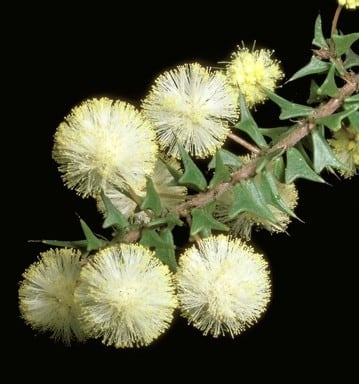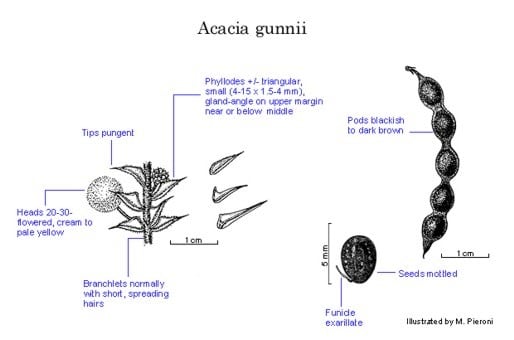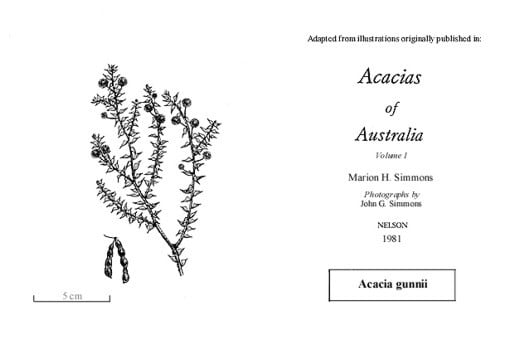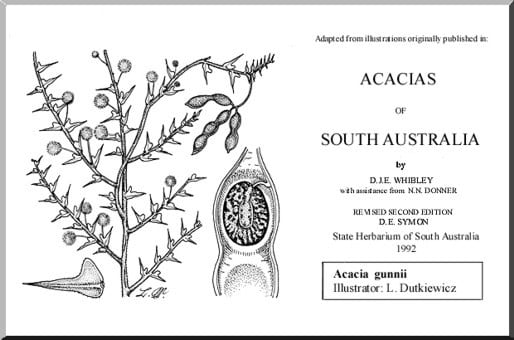Acacia gunnii Benth.
WATTLE
Acacias of Australia
Common Name
Ploughshare Wattle, Dog’s Tooth Wattle
Family
Fabaceae
Distribution
Widespread and sometimes locally abundant in eastern Australia on the Great Divide and its associated slopes from the Grampians, Vic., through N.S.W. and A.C.T. to near Stanthorpe, Qld; also in S.A. in the Tothill Ra. and Adelaide Hills and in N and E Tas.
Description
Diffuse shrub, prostrate or erect, to 1 m high. Branchlets normally hirsutellous, infrequently glabrous. Stipules persistent. Phyllodes ±sessile, patent to inclined, inequilateral, shape variable, usually with a pronounced rounded or triangular gland-angle on adaxial margin near or below middle, 4–15 mm long, 1.5–4 (–5) mm wide, l:w usually 1.5–5, acuminate, pungent, rigid, glabrous or hirsutellous, green; midrib prominent, central or near lower margin. Inflorescences simple, normally 1 per axil; peduncles 4–10 (–15) mm long, glabrous or hairy; basal bracts 3; heads globular, 20–30-flowered, cream to pale yellow; bracteoles acuminate. Flowers 5-merous; sepals c. 2/3-united; petals often prominently 1-nerved. Pods to 4 cm long, 4–5 mm wide, firmly chartaceous to thinly coriaceous, dark brown to blackish, glabrous, sometimes hairy. Seeds longitudinal to oblique, broadly elliptic to spherical, c. 3 mm long, variably mottled, exarillate; funicle filiform.
Habitat
Grows in Eucalyptus open forest or (in Tas.) coastal heath.
Specimens
S.A.: near Eagle On the Hill, Adelaide Hills, 27 July 1972, B.R.Maslin s.n. (AD, NSW, PERTH). Qld: Amiens near Stanthorpe, J.Harslett in G.Ward 389 (BRI). N.S.W.: 4.8 km S of Peelwood, E.F.Constable 4113 (NSW, PERTH). A.C.T.: mid-east slope of Black Mtn, Canberra, R.Pullen 2102 (BRI). Vic.: Grampians, Aug. 1902, H.B.Williamson s.n. (NSW). Tas.: Hobart, L.Rodway s.n. (NSW).
Notes
Although the name A. vomeriformis has been generally used for this species, F.J.H. von Mueller, J. Proc. Linn. Soc., Bot. 3:119 (1859) first placed A. vomeriformis in synonymy under A. gunnii and he must be followed.
Phyllodes are very variable, ranging in shape from semi-trullate, lanceolate or broadly to narrowly triangular, but the normally prominent gland-angle on their adaxial margin serves to distinguish the species from other members of the ‘A. ulicifolia group’. However, on some specimens, especially from N.S.W., the phyllodes are very narrow and the gland-angle is much-reduced, making them difficult to distinguish from A. ulicifolia (e.g. Tianjara Falls, N.S.W., E.F.Constable 6989, NSW). These two species are sometimes sympatric and possible hybrids between them are reported by T.J.Entwistle et al., in N.G.Walsh & T.J.Entwistle (eds), Fl. Victoria 3: 630 (1996). Specimens with rather elongate phyllodes (l:w = 7.5) occur with the normal form in the Blue Mtns, N.S.W. Some forms resemble A. amblygona.
FOA Reference
Data derived from Flora of Australia Volumes 11A (2001), 11B (2001) and 12 (1998), products of ABRS, ©Commonwealth of Australia
Author
B.R.Maslin
Minor edits by B.R.Maslin & J.Rogers
This identification key and fact sheets are available as a mobile application:
URL: https://apps.lucidcentral.org/wattle/
© Copyright 2018. All rights reserved.











